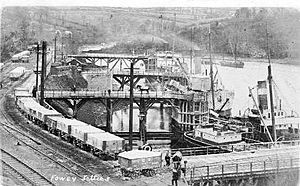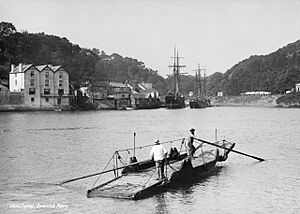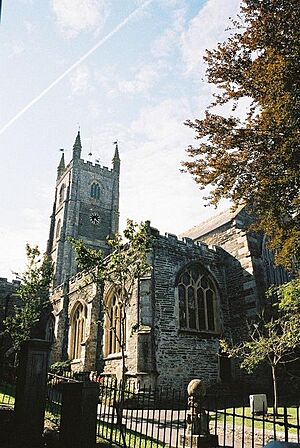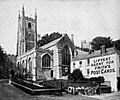Fowey facts for kids
Quick facts for kids Fowey
|
|
|---|---|
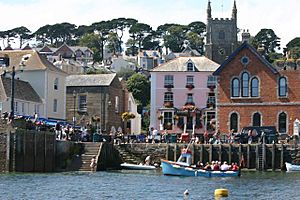 Fowey, Town Quay: Fowey Town Hall (grey stone on the centre left), The King of Prussia Public House (pink in the centre) and the Royal British Legion Club (red brick on right) |
|
| Lua error in Module:Location_map at line 530: Unable to find the specified location map definition: "Module:Location map/data/Cornwall (mainland)" does not exist. | |
| Population | 2,315 (United Kingdom Census 2011) |
| OS grid reference | SX126516 |
| Civil parish |
|
| Unitary authority | |
| Ceremonial county | |
| Region | |
| Country | England |
| Sovereign state | United Kingdom |
| Post town | FOWEY |
| Postcode district | PL23 |
| Dialling code | 01726 |
| Police | Devon and Cornwall |
| Fire | Cornwall |
| Ambulance | South Western |
| EU Parliament | South West England |
| UK Parliament |
|
Fowey (pronounced FOY) is a port town and parish located at the mouth of the River Fowey in south Cornwall, England. The town has been around for a very long time, even before the Norman invasion of 1066. Its local church was first built around the 7th century.
The River Fowey estuary forms a natural harbour, which helped the town become an important trading center. This sheltered harbour was also used by privateers, who were like legal pirates hired by the king. Later, the Lostwithiel and Fowey Railway brought a special type of clay called China clay here to be shipped out to other places.
Contents
History of Fowey
Early Times
The Domesday Book, a famous survey from the late 1000s, mentions areas near Fowey. Around the year 1300, a priory (a type of monastery) gave a special permission, called a charter, to the people living in Fowey. This allowed the town to grow.
In medieval times, Fowey was a busy trading port. Its natural harbour allowed ships to trade with countries in Europe. Ship owners often rented their vessels to the king for wars. However, Fowey also gained a reputation for piracy. A group of privateers known as the 'Fowey Gallants' were even allowed to capture enemy ships during the Hundred Years' War.
To protect the harbour, two blockhouses (small forts) were built around 1540. These defenses proved useful when they helped fight off a Dutch attack in 1667.
During the English Civil War in the 1640s, the people of Fowey mostly supported the Royalists (King Charles I). In 1644, the Parliamentarian army, led by the Earl of Essex, occupied the area around Fowey. However, the Royalist army soon surrounded them. King Charles I himself nearly got shot by a musket while watching Fowey from Hall Walk. Most of the Parliamentarian soldiers surrendered, though some managed to escape by sea.
Later Developments
Over time, Fowey's harbour became less busy as trade moved to other ports like Plymouth. Fishing became more important. Local merchants sometimes worked as privateers and even did some smuggling.
Later, industries like tin, copper, and iron mining, along with china clay pits, grew in the area. This led to improvements in other harbours nearby. Fowey had to wait until the late 1800s for similar developments. But its deep-water harbour and a new rail link soon gave it an advantage over other ports. A beacon tower was built on Gribben Head to help ships navigate safely.
In 1869, the Fowey Harbour Commissioners were set up to improve the harbour. Railways were built to bring goods, especially china clay, to new jetties. The Lostwithiel and Fowey Railway opened in 1869, and the Cornwall Minerals Railway (CMR) opened in 1873. These railways helped Fowey become a major port for exporting china clay.
The Royal National Lifeboat Institution (RNLI) opened the Fowey Lifeboat Station in 1922 to help rescue people at sea. Today, Fowey has two lifeboats: a large all-weather boat and a smaller inshore lifeboat.
During World War II, Fowey was a very important port. It was the main place for loading ammunition for the US 29th Division, which landed on Omaha Beach on D Day.
How Fowey is Governed
Fowey has a civil parish with a town council and a mayor. This means local decisions are made by people from the town. The town council works with Cornwall Council to manage local services.
The parish of Fowey includes the town itself and the coastal area between the River Fowey and St Austell Bay. This includes places like Gribben Head and small villages such as Polkerris and Readymoney Cove.
For the national government, Fowey is part of the St Austell and Newquay constituency. This is the area that elects a Member of Parliament to the UK Parliament.
Fowey's Location and Landscape
Fowey is a small town and cargo port at the mouth of the River Fowey in south Cornwall, England. It sits at the entrance to a large valley that was flooded after the last ice age. The melting ice caused sea levels to rise, creating a big natural harbour that ships can use for seven miles inland.
Fowey is part of the South Coast (Eastern Section) of the Cornwall Area of Outstanding Natural Beauty. This means the area has special natural beauty that is protected. The town is also at the end of the Saints' Way, a historic walking route. There are ferries that cross the river to Polruan (for walkers) and Bodinnick (for vehicles).
The town has many old buildings, including the ruins of St Catherine's Castle. Readymoney Cove is a local beach where people can relax.
In 2011, Fowey had a population of 2,395 people.
Religious Places
An old story says that Jesus visited Fowey as a child with Joseph of Arimathea. Joseph was a merchant who supposedly visited local tin mines. There is a cross at the entrance to the River Fowey, known as "Punches Cross," which is said to remember this visit.
Near the harbour entrance, there's a small grassy area called "Johnny May's Chapel." This name is thought to be from a Methodist preacher who held secret meetings there when their religion was not allowed.
The main church in Fowey is the Church of St Fimbarrus, Fowey, also called Fowey Parish Church. It's a very old building, first built in the early 1300s. It belongs to the Church of England.
Economy and Jobs
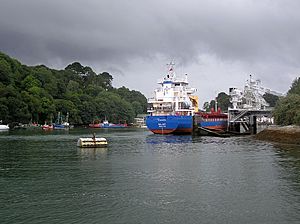
Fowey has been an important port for hundreds of years. It started as a trading and naval town, then became a major center for exporting china clay. Today, the harbour is busy with fishing boats and yachts.
Tourism is also a very important part of Fowey's economy. It brings in a lot of money and provides more than half of the jobs in the town. Many people visit Fowey for its beautiful scenery and history.
Getting Around Fowey
Even though the Fowey railway station closed for passengers in 1965, the railway line from Lostwithiel to Fowey is still used for goods. It carries large amounts of china clay to the jetties at Carne Point. The closest passenger train station is at Par. From there, you can catch trains to other towns like Penzance, Plymouth, and London.
There are also regular bus services connecting Fowey to Par station and St Austell. A special Town Bus runs frequently from the town center to the main car park.
You can cross the river using ferry services. There's a vehicle ferry to Bodinnick and a foot ferry to Polruan. During warmer months, a water taxi service operates, and a foot ferry can take you to the fishing village of Mevagissey.
Education in Fowey
Fowey has two schools: Fowey Primary School for younger students and Fowey River Academy for older students. Both schools are located on Windmill Road.
Culture and Arts
Fowey has inspired many famous authors and artists. Sir Arthur Quiller-Couch, a well-known writer, lived in Fowey. Daphne du Maurier, a very famous English author, also lived here. The du Maurier Festival Society holds the Fowey Festival of Arts and Literature every May, celebrating her birth month.
Many visual artists have also lived in Fowey, including Fred Yates and Mabel Lucie Attwell, who was known for her cute drawings of children. Fowey also hosts an annual Christmas craft market.
Sports and Activities
The coast around Fowey is popular for fishing and spear-fishing. You can find many sea creatures like mullet, bass, mackerel, lobsters, and cuttlefish. The Fowey Aquarium in the town center lets you see many of these species, including a very rare Albino Bull Huss.
The Royal Fowey Yacht Club is located on the harbour front. There's also a Pilot Gig Rowing Club that competes in races around Cornwall, with an event held in Fowey during the Regatta week.
Cornish wrestling tournaments, where people compete for prizes, used to be held at the Fowey Grammar School sports ground.
Public Services
Fowey has a doctors' surgery called the 'Fowey River Practice' on Rawlings Lane. It's part of a larger group that includes two other surgeries in nearby towns.
Famous People from Fowey
Many interesting people have connections to Fowey:
- Hugh Peters (1600s), a preacher, was born in Fowey.
- Mary Bryant (born 1765) was born in Fowey. She was sent to Australia as a convict but became famous for being one of the first to escape.
- Kenneth Grahame (1859–1932), who wrote The Wind in the Willows, lived in Fowey for part of the year.
- Sir Arthur Quiller-Couch (1863–1944), a writer and professor, settled in Fowey and lived there for the rest of his life.
- Mabel Lucie Attwell (1879–1964), a British illustrator known for her cute drawings of children, lived and died in Fowey.
- Daphne du Maurier (1907–1989), a famous English author and playwright, lived in Fowey. She wrote popular books like Rebecca and Jamaica Inn.
- Antony Hewish (1924–2021), who won the Nobel Prize for Physics in 1974, was born here.
- Dawn French (born 1957), a well-known actress and comedian, lived in Fowey for many years.
Several entertainers also have homes in or around Fowey, including Richard Madeley and Judy Finnigan, and Gloria Hunniford.
Images for kids
-
Church in Fowey (period 1850-98) by Francis Frith
See also
 In Spanish: Fowey para niños
In Spanish: Fowey para niños


